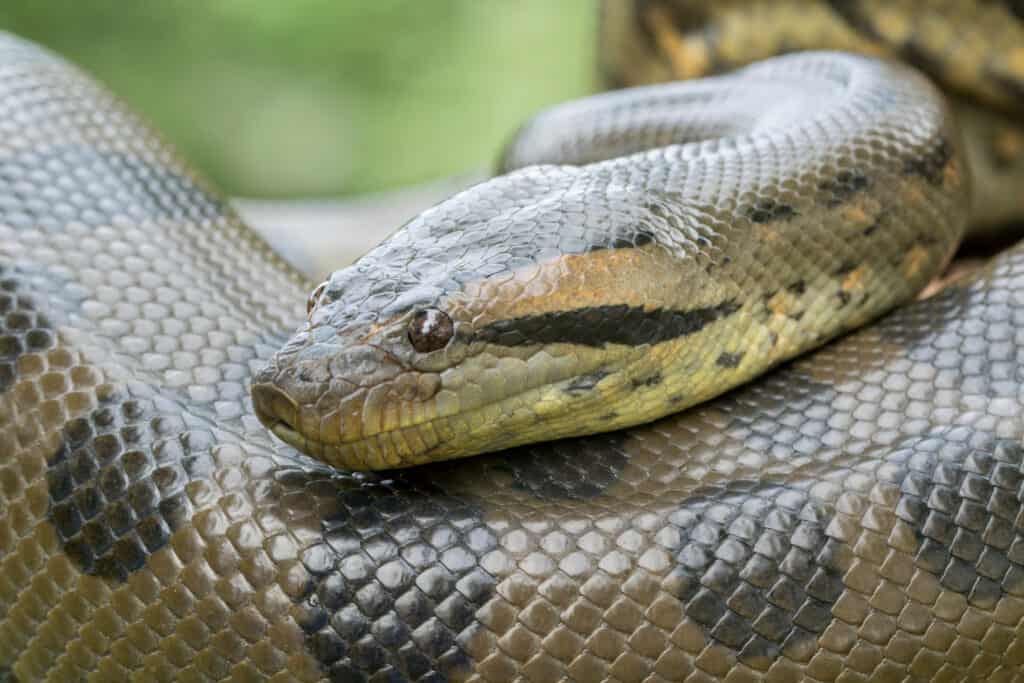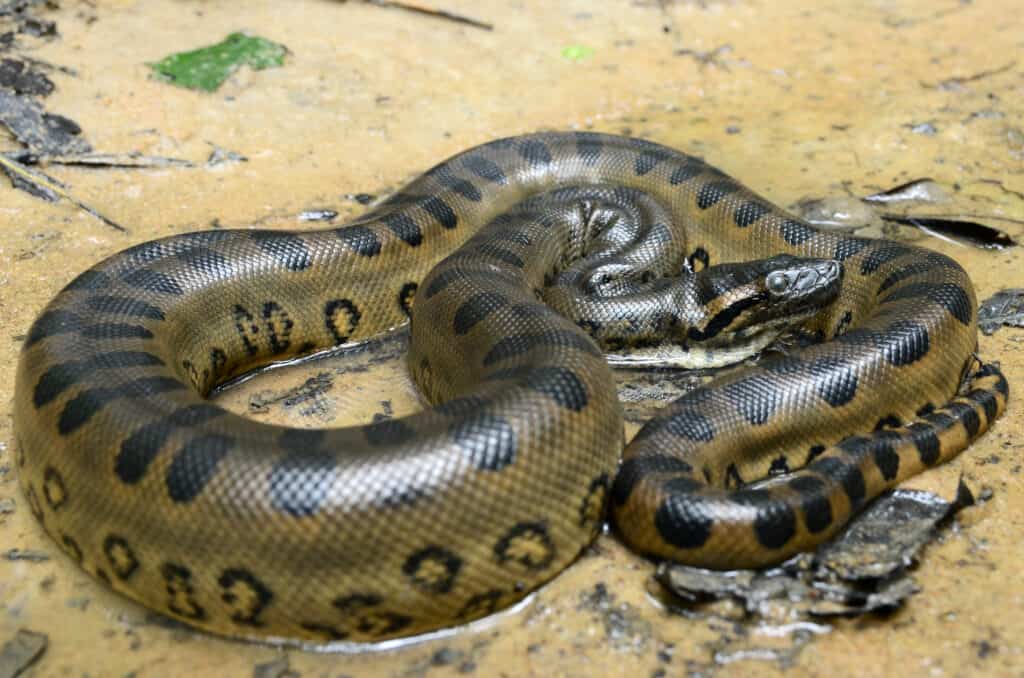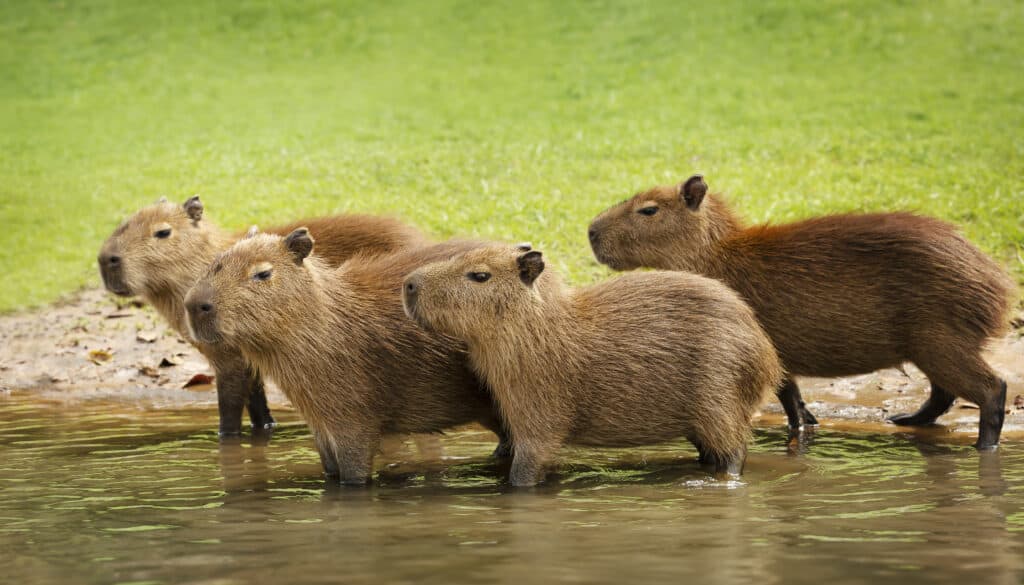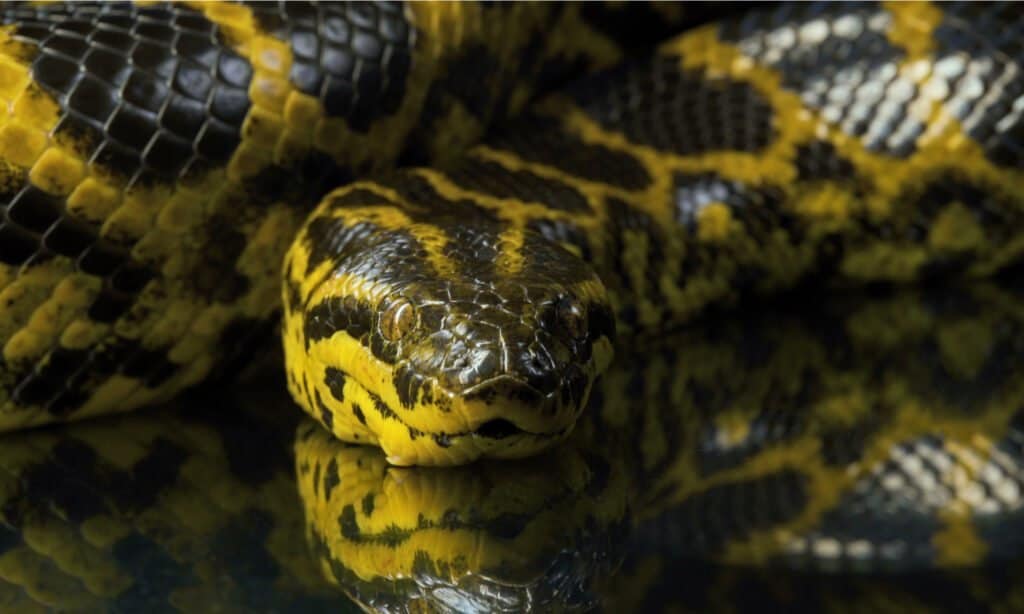Key Points:
- The green anaconda is the largest and heaviest snake species on Earth and can grow to lengths of over 20 feet and weigh more than 200 pounds.
- The biggest anaconda on record measured 33 feet in length, 3 feet across at its widest part, and weighed around 880 pounds.
- Elements that led to the growth of the largest anacondas include genetic factors, abundant food supplies, longevity, and a lack of predation and competition.
If you’ve ever been fascinated by the world of snakes, you’re in for a real treat. Today, we’ll dive into the realm of anacondas, those magnificent giants that belong to the boa family, Boidae. With four recognized species slithering through South America, these creatures have captured our imagination for centuries.
Perhaps the most famous of them all is the green anaconda, the largest and most well-known species of its kind. These behemoths have made their way into pop culture, legends, and myths, but they also play a crucial role in their native ecosystems. So now, brace yourself as we embark on a journey to unravel the story of the largest anaconda ever recorded, which was longer than not one but two giraffes! Can you believe it?
In this article, we’ll dissect the factors that contributed to this massive size and explore the many aspects of anaconda life, from their habitats and prey to the challenges they face in the wild.
So, grab your adventurer’s hat, and let’s get started on this epic exploration of the largest anaconda known to humankind!

The Green Anaconda: A Brief Overview
Before we dive deeper into the fascinating world of the largest anaconda ever recorded, let’s take a step back and get acquainted with the green anaconda, the species to which this colossal snake belongs. Known for their impressive size and captivating presence, green anacondas have a story that’s worth exploring.

There have been about several sightings in Florida of the green anaconda, the largest snake in the world.
©Mark_Kostich/Shutterstock.com
A South American Giant
The green anaconda, scientifically known as Eunectes murinus, is native to South America, primarily inhabiting the tropical rainforests, swamps, and rivers of countries like Brazil, Colombia, Venezuela, and Peru. As the largest and heaviest snake species in the world, these reptiles can reach impressive lengths of over 20 feet and weigh more than 200 pounds.
Master of Disguise
These stealthy predators have mastered the art of camouflage. Their greenish-brown skin, adorned with black oval-shaped spots, helps them blend seamlessly into their lush surroundings. In addition, their eyes and nostrils are positioned on the top of their heads, allowing them to stay mostly submerged while they patiently await their prey.
Non-Venomous Hunters
Despite their intimidating size, green anacondas are non-venomous. Instead, they rely on their incredible strength and constriction to subdue their prey. Once they’ve captured a meal, they wrap their powerful bodies around it, applying pressure until the prey can no longer breathe. Then, they swallow their meal whole, thanks to their flexible jaws that can stretch to accommodate large prey.
Reproduction and Lifespan
Green anacondas are ovoviviparous, meaning that they give birth to live young. Females can produce up to 82 offspring at a time, with the young snakes emerging fully capable of fending for themselves. In the wild, green anacondas can live for 10 to 15 years, while in captivity, they have been known to survive for more than 30 years.
The Largest Anaconda Ever Recorded

“Anaconda” comes from the Sinhalese “henakanday” (“thunder snake”), or the Tamil “anaikondran” (
elephant
killer).
©Patrick K. Campbell/Shutterstock.com
The extraordinary tale of the largest anaconda ever documented is truly remarkable. This gigantic serpent outshines other large snakes with its astonishing measurements. Let’s explore the record-breaking snake’s incredible size, its discovery at a construction site in Brazil, and the unfortunate circumstances surrounding its demise.
Discovery of the Record-Breaking Specimen
In Brazil, at a construction site, workers were in for a shocking surprise. Amid the chaos of construction, the slithering titan emerged, measuring an astounding 33 feet in length, 3 feet across at its widest part, and weighing about 880 pounds. The sheer size of this snake garnered instant attention, making headlines across the globe.
Longer Than Two Giraffes
To provide a clear visual of this anaconda’s enormity, consider this: if you were to place two adult giraffes head-to-tail, the anaconda would still surpass their combined length. This incredible comparison not only highlights the snake’s extreme size but also offers insight into the challenges it might face in the wild due to its massive proportions.
Verification, Documentation, and Further Studies
Upon discovering the record-breaking anaconda, experts were called in to verify the snake’s measurements and document the specimen. In addition, photographic and video evidence was meticulously collected, preserving the memory of this extraordinary snake for posterity.
The record-breaking anaconda would have undoubtedly become the subject of numerous scientific publications and studies, providing valuable insights for the herpetological community.
The Tragic Death of the Largest Anaconda
Sadly, the largest anaconda ever found met an untimely end at the hands of humans. The snake either died as a result of the controlled explosion at the construction site or was killed by construction workers after it emerged. The tragic loss of this exceptional specimen highlights the delicate balance between human development and the preservation of wildlife.
Why Did It Grow So Large?

The genetic makeup of an individual anaconda largely influences its potential for growth and overall size.
As we’ve learned about the record-breaking anaconda, you might be wondering what factors contributed to its staggering size. Let’s explore the various elements that led to the incredible growth of the largest anaconda ever recorded.
#1: Genetic Factors
Genetics plays a crucial role in determining the size of an anaconda. Some snakes may inherit a predisposition for rapid growth or larger size from their parents. However, in the case of the record-breaking anaconda, it’s likely that a combination of favorable genes contributed to its exceptional size.
#2: Abundant Food Supply
A plentiful food supply is essential for an anaconda to grow to its full potential. The largest anaconda may have had access to a rich source of food, such as capybaras, deer, and caimans. This abundance of prey would have allowed the snake to consume larger meals more frequently, leading to rapid growth and extraordinary size.
#3: Longevity
An anaconda’s age also contributes to its size. The longer a snake lives, the more opportunities it has to grow. The record-breaking anaconda may have enjoyed a long life, free from major threats and illnesses, enabling it to reach its impressive length and girth.
#4: Optimal Environmental Conditions
The environment in which an anaconda lives can significantly impact its growth. Favorable temperatures, humidity levels, and access to suitable shelter all play a part in promoting healthy growth. It’s likely that the record-breaking anaconda lived in an environment that provided the ideal conditions for it to thrive.
#5: Lack of Predation and Competition
Finally, the absence of predators and competition for resources could have also played a role in the exceptional size of the largest anaconda. With fewer threats and more resources at its disposal, this snake would have been able to grow without hindrance, ultimately reaching its colossal dimensions.
Anaconda Prey

Capybaras are commonly eaten by anacondas.
©Giedriius/Shutterstock.com
Understanding the feeding habits of anacondas gives us valuable insights into their behavior and ecological role. Let’s delve into the diet of these powerful predators, examining the types of prey they consume and the hunting techniques they employ.
A Varied Diet
Anacondas are opportunistic predators, meaning they’ll eat a wide variety of prey, depending on what’s available in their environment. Their diet mainly consists of mammals, birds, reptiles, and fish. Some common prey items include capybaras, deer, caimans, turtles, and various bird species.
Ambush Hunters
Anacondas are experts at ambush hunting. They lie in wait, partially submerged in water, patiently waiting for unsuspecting prey to come within striking distance. Once the prey is close enough, the anaconda strikes with lightning speed, latching onto the animal with its sharp, backward-facing teeth.
The Power of Constriction
Although anacondas are non-venomous, they possess an incredible ability to subdue their prey: constriction. After securing a firm grip on their prey, anacondas coil their powerful bodies around it, applying a crushing pressure that prevents the animal from breathing. Then, as the prey exhales, the snake tightens its grip, effectively suffocating the animal.
Swallowing Prey Whole
Anacondas have an amazing capacity to consume large meals thanks to their highly flexible jaws. Once the prey is dead, the snake slowly works its jaws around the animal, swallowing it whole. During this process, the anaconda’s muscles contract in waves, helping to move the prey down its esophagus and into its stomach.
Infrequent Meals
Due to the enormous size of their prey, anacondas don’t need to eat as often as other predators. Therefore, after consuming a large meal, an anaconda can go weeks or months without needing to eat again. This impressive ability to sustain itself on infrequent meals allows anacondas to thrive in environments where food may not always be available and abundant.
Implications of Such Large Size
The remarkable size of the largest anaconda ever recorded undoubtedly sparks curiosity about the implications of being such a colossal creature. So let’s explore the advantages and disadvantages of the anaconda’s exceptional size and how it impacts its life in the wild.
Advantages of a Massive Size
The incredible size of the largest anaconda offers a variety of advantages that contribute to its survival and success in the wild. Let’s explore the key benefits of being such a massive creature and how these attributes play a crucial role in the life of this extraordinary snake.
- Dominance over prey: One of the most obvious benefits of being a giant snake is the ability to overpower a wide range of prey. The anaconda’s immense size and strength enable it to capture and consume large animals with relative ease, ensuring a steady food supply.
- Fewer predators: A massive size also means that the anaconda faces fewer natural predators. In addition, the sheer bulk of the snake makes it a challenging target for even the most determined of predators, allowing the anaconda to live with a greater sense of security.
- Enhanced reproductive success: Larger female anacondas tend to have greater reproductive success, as they can carry and give birth to a larger number of offspring. This increased reproductive capacity helps ensure the continuation of their genetic line.
Disadvantages of a Massive Size
While the impressive size of the largest anaconda provides certain benefits, it also comes with its own set of challenges. Let’s delve into the disadvantages associated with being such a colossal snake and how these factors can impact its life and interactions within its environment.
- Mobility challenges: The sheer size of the largest anaconda ever recorded comes with mobility challenges. Moving through dense vegetation or traversing long distances on land can be difficult and energy-consuming for such a massive creature.
- Increased energy demands: A larger body requires more energy to sustain itself. This means that the record-breaking anaconda would have needed to consume more food to meet its energy demands, which could be challenging in environments where prey is scarce.
- Human encounters: Unfortunately, as we saw with the largest anaconda ever recorded, a massive size can lead to increased encounters with humans. These interactions often end poorly for the snake, as people may perceive it as a threat, resulting in injury or death for the anaconda.
Threats to Anaconda Populations

So far sightings of the yellow anaconda, which can grow to 20 feet long, have been confined to the Florida Everglades.
©Chris Tefme/Shutterstock.com
Although anacondas are among the top predators in their ecosystems, they still face a variety of threats that can impact their populations. Let’s examine the main factors that pose a risk to these remarkable snakes and the potential consequences for their survival in the wild.
Habitat Loss and Fragmentation
One of the most significant threats to anaconda populations is habitat loss and fragmentation. As human populations expand and land is cleared for agriculture, urban development, and infrastructure projects, the natural habitats of anacondas are increasingly diminished. This loss of habitat reduces the available space for these snakes to live and hunt and disrupts the delicate balance of their ecosystems.
Human Encounters and Persecution
Anacondas often suffer due to negative human interactions. Many people fear these large snakes, leading to persecution and killing whenever they are encountered. In some cases, such as with the largest anaconda ever recorded, human activity directly resulted in the death of the snake.
Illegal Wildlife Trade
Another threat facing anaconda populations is the illegal wildlife trade. These snakes are sometimes captured for their skins, which are used in the fashion industry or for the exotic pet trade. In addition, removing anacondas from their natural habitats disrupts their populations and places additional stress on the individuals involved, often leading to injury or death.
Climate Change
Climate change is an ever-growing concern that poses a risk to anaconda populations. As temperatures rise and precipitation patterns shift, the habitats and ecosystems in which these snakes reside may undergo significant changes. These alterations can lead to a loss of suitable habitat, reduced prey availability, and increased competition for resources.
Key Takeaways
We’ve ventured through the incredible world of anacondas and unraveled the mystery behind the colossal size of the largest anaconda ever recorded. From genetic factors to environmental conditions, it’s clear that a perfect storm of circumstances led to the growth of this awe-inspiring snake.
But our journey doesn’t end here. The story of the largest anaconda also highlights the importance of understanding and protecting these giant snakes. These fascinating creatures play a crucial role in maintaining the balance of their ecosystems, and it’s up to us to ensure their survival. So as we conclude our thrilling adventure, let’s remember that there’s still so much more to learn about anacondas and their captivating world.
Discover the "Monster" Snake 5X Bigger than an Anaconda
Every day A-Z Animals sends out some of the most incredible facts in the world from our free newsletter. Want to discover the 10 most beautiful snakes in the world, a "snake island" where you're never more than 3 feet from danger, or a "monster" snake 5X larger than an anaconda? Then sign up right now and you'll start receiving our daily newsletter absolutely free.
Thank you for reading! Have some feedback for us? Contact the AZ Animals editorial team.








